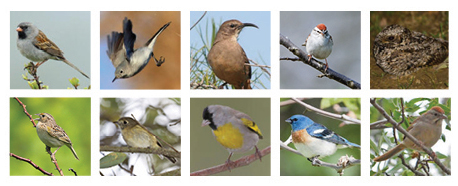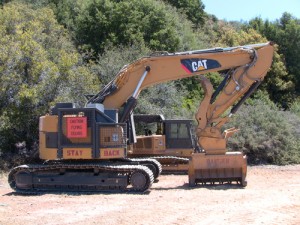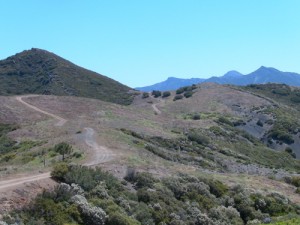ForestWatch Urges Officials to Take Immediate Steps to Protect Bird Nests along Nordhoff Ridge
Ojai, Calif. – This week, ForestWatch urged the U.S. Forest Service to avoid clearing large swaths of native chaparral vegetation on the Los Padres National Forest during the nesting season for migratory songbirds. This most recent warning came just days after the 20th Anniversary of International Migratory Bird Day, which is celebrated in Canada, the United States, Mexico, Central and South America, and the Caribbean to bring attention to one of the most important and spectacular events in the Americas – bird migration.
The recent vegetation clearing is part of a massive fuelbreak project approved by the U.S. Forest Service in 2008. Using a giant lawnmower-like machine called a “masticator,” the project calls for a series of 300 foot-wide fuelbreaks totaling 51 miles, extending from Lake Casitas to the Upper Ojai Valley. The project was approved after the Forest Service prepared an Environmental Assessment, which identified various ways to avoid significant impacts to wildlife and habitat in the project area.
Among the several protective measures outlined in the EA, the Forest Service committed to hiring a qualified wildlife biologist to survey stands of chaparral before they were cleared. If any bird nests were identified during these surveys, then the nest – and an adequate buffer zone – would be avoided by clearing operations. This “survey-and-avoid” commitment applies only during the bird nesting season, from March through August, and was formally adopted when the Forest Service approved this project on March 17, 2008.
But in early May, ForestWatch learned that the Forest Service was conducting vegetation clearing along a remote section of Nordhoff Ridge, between Chief Peak and the Topatopa Bluff. After spending a day out in the field, documenting several freshly-cleared areas, it became immediately evident that the Forest Service was not implementing its own measures to protect bird nests in the area. Not a single flagged bird nest was found, and afterwards, forest officials confirmed that they were not conducting bird surveys – even though it is now the height of bird nesting season.
Our May 21 letter reminds the Forest Service of its commitments under the Migratory Bird Treaty Act (“MBTA”), a federal law that has been on the books since 1918 and that implements several international treaties and agreements for the protection of migratory birds worldwide. Under the MBTA, it is unlawful to destroy bird nests or eggs without a permit. Several provisions of the California Fish & Game Code also prohibit the destruction of bird nests. Because of these laws, agencies and landowners typically avoid clearing native vegetation from February through August when most local bird species are building their nests and raising their young.
The letter comes less than two months after ForestWatch sent a similar warning to the Forest Service about a similar vegetation clearing project in Santa Barbara County.
“It remains unclear why the Forest Service is not fulfilling its own commitments to protect migratory birds,” said Jeff Kuyper, executive director of Los Padres ForestWatch. “It is unacceptable and illegal to mow down bird nests and young songbirds during the height of the nesting season. The Forest Service has a responsibility to protect our region’s birds and we hope they will take this opportunity to do the right thing.”
The letter demands that the Forest Service immediately implement its “survey-and-avoid” commitments, or stop all work pending revision of the EA. The letter also reminds the agency that work can continue on the project after the bird nesting season ends in September, without the need to do time-intensive surveys.
Importance of Migratory Birds
Migratory birds are perhaps the most highly valued component of North America’s biological diversity, with approximately 1,200 species representing nearly 15% of the world’s known bird species. More than 300 of these bird species – one-quarter of all bird species on the continent – are found in the Los Padres National Forest, and several areas of the forest are formally designated as Globally Important Bird Areas.
The seasonal movement of migratory birds is one of the most complex and compelling dramas in the natural world. Migratory birds embark twice each year on long-distance journeys between their breeding areas and their wintering grounds, which are sometimes separated by thousands of miles. State, federal, and international law all recognize the importance of protecting migratory bird species from harm.

Top left to right: black-chinned sparrow, blue-gray gnatcatcher, California thrasher, chipping sparrow. Bottom left to right: common poorwill, grasshopper sparrow, Hutton’s vireo, Lawrence’s goldfinch, Lazuli bunting, rufous-crowned sparrow
At least eight “high priority” bird species build nests in the project area along Nordhoff Ridge, including common poorwill, blue‐gray gnatcatcher, California thrasher, Hutton’s vireo, Lazuli bunting, rufous‐crowned sparrow, Chipping sparrow, black‐chinned sparrow, grasshopper sparrow, and Lawrence’s goldfinch. Three of these bird species – grasshopper sparrow, black-chinned sparrow, and Lawrence’s goldfinch – are classified as Birds of Conservation Concern and are likely to become threatened with extinction without additional conservation measures – such as timing restrictions to avoid the nesting season.
What’s Next
ForestWatch will continue to monitor the Nordhoff Ridge area to ensure that the Forest Service fulfills its commitments and takes all steps necessary to protect nesting birds in the area. We will also continue to work with various stakeholders to implement a forest-wide strategy to enhance protections for migratory birds across the Los Padres National Forest
Read More
A similar situation is happening along the crest of the Santa Ynez Mountain from Refugio Pass to Romero Saddle. ForestWatch has stepped in; read about it at https://lpfw.org/index.php/caminocielobirds/
Photo credits for birds: Top left to right: black-chinned sparrow – Maggie Smith, blue-gray gnatcatcher – Ken Schneider, California thrasher – Almiyi, chipping sparrow – Kelly Colgan Azar, Bottom left to right: common poorwill – Ken Ichi, grasshopper sparrow – Ken Schneider, Hutton’s vireo – Bill Bouton, Lawrence’s goldfinch – Scott Streit, Lazuli bunting – Bill Bouton, rufous-crowned sparrow – Jerry Oldenettel








Comments are closed.